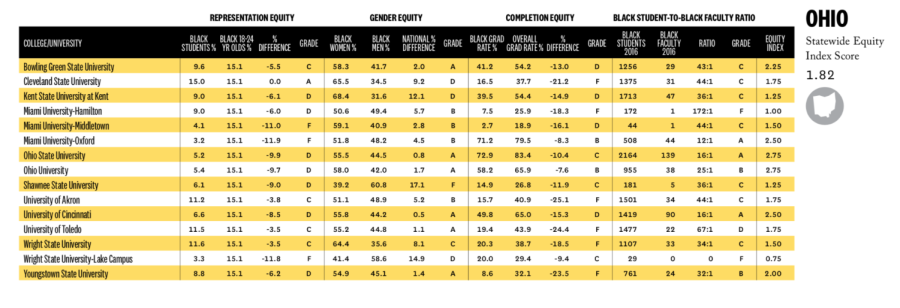Kent State receives failing diversity grade
November 18, 2018
As some students peer around the classroom, they find themselves in a sea full of faces that mostly look different from their own.
Diversity has been a top initiative for Kent State although recent statistics say otherwise.
The University of Southern California’s Race and Equity Center released a nationwide equity report card titled “Black Students at Public Colleges and Universities: A 50-State Report.” Kent State’s main campus received a failing grade of a D in regard to equity and diversity.
“The classroom structure is (mostly) Caucasian,” Tyler Smalls, a junior integrated studies major, said. “If I had to break it down in a percentage, I would say 65 or 75 percent (Caucasian)…”
In Smalls’ opinion, he believed that the percentage futher breaks down into 15 percent Asian and the rest black.
“Some of the most recent data that we had for schools was produced in 2016 federal data,” Isaiah Simmons, the research associate at USC Race and Equity Center and co-author of the report, said.
“So we do want to account for schools that have been making progress recently and that data wasn’t captured because of a time limitation.”
The report measures diversity by gender equity, completion rates of black students, representation within the area compared to the state and black student to black faculty ratio.
“I actually wasn’t surprised because I was aware of what the numbers were,” Amoaba Gooden, an associate professor of Pan-African Studies at Kent State, said.
The publication includes the demographics of black students from public four-year institutions across the country. Public universities in Ohio scored a 1.82 for the statewide equity index.
This index score works as a grade point average for each school. The average equity index score across the country is 2.02, with no campus scoring higher than a 3.5. The higher the equity index score, the more diverse the campus.
“We have work to do maybe in enrollment, and we have work to do with graduation rates,” Alfreda Brown, the vice president of the Division of Diversity, Equity and Inclusion at Kent State, said.
According to the report, black students make up nine percent of the population on Kent State’s main campus. Within that percentage, black males make up 31.6 percent compared to 68.4 of black females.
The current percentage of black people between the ages of 18 and 24 at Kent State is 15.1 percent, while the national percentage of the same age group is 14.6 percent.
In addition, the report said only 9.8 percent of “full-time, degree-seeking undergraduates at public colleges and universities” are black.
“Equity work and diversity work takes time in general,” Simmons said. “One of the biggest things to take into account is student-faculty feedback.”
On average, Kent State sees 54.4 percent of its students graduate within four years. Black graduates made up 39.5 percent of that number.
The purpose of the report is for universities to seek change and to diversify the student population.
“Collaboration is one of my biggest hopes from the report — anything that allows students to get honest perspectives from other black students on campus as well as faculty members,” Simmons said.
The university has many initiatives in place to increase the diversity on campus, such as working with other offices. The Division of Diversity, Equity and Inclusion aims to create a more diverse campus.
“We have a group called SDAC, which is Student Diversity Action Council and we have the University Diversity Action Council (UDAC),” Brown said. “We’re working with (Kent State’s offices of) Academic Affairs, University College and Student Affairs.”
Authors of the report hope the results lead to increased awareness on the lack of diversity on campuses across the country.
“One of the biggest things I think you can do to increase awareness is simply just listening to your students and faculty members,” Simmons said.
Nyla Henderson is a diversity reporter. Contact her at [email protected].












